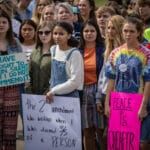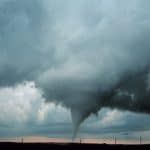Nuclear terrorism: Correcting the future
By Hugh Gusterson | June 4, 2007
If we lose Washington, we better get our story straight. Otherwise, history will rewrite itself.
On 9/11, terrorists attacked the United States, and we lost two skyscrapers. The next time it
may be a city.
If you doubt this, read William Langewiesche’s chilling new book,
The Atomic Bazaar. Russia has enough highly enriched uranium lying around to make tens of
thousands of Hiroshima-type bombs. The Hiroshima design was so simple that Oppenheimer’s boys never
tested it before dropping it on Hiroshima. Expecting none of Russia’s uranium to get into terrorist
hands is as realistic as expecting the United States to end illegal immigration or the heroin
trade. Borders are porous, and the folks guarding all that uranium in Russia are not paid very
well.
Since the city we are most likely to lose is the one in which I live, Washington D.C., I may not
be around to write about the event after the fact. So instead, let me write about it before the
fact.
Indeed, more of us need to write about it before the fact. This is not only because “imagining
the real” (in Robert Jay Lifton’s fine phrase) may encourage governments to get more serious about
preventive action, but also because when the event comes, it will be understood in terms of the
narratives that preceded and framed it. We need to create those narratives now. (Share this column
with a friend.)
We already know the narrative frame that will be put around the smoking ruins of a U.S. city by
the national security apparatus and conservatives. We saw it starting on September 12, 2001. We
will be told we were attacked because we have not militarized our society enough, and the attack
will be used to justify more military spending, new military actions abroad, and further sacrifice
of civil liberties at home. When you live so deep inside militarism that you cannot see outside it,
military solutions become a reflex reaction–even to problems that militarism caused. The poison
becomes the cure. If you think the post-9/11 smorgasbord of Abu Ghraib, illegal domestic
wiretapping, and attacks on media and academic critics were bad, wait ’til you see what happens
after a city goes missing.
Our task is to create a counternarrative that joins the dots in a different way. Anti-nuclear
activists did this in the 1980s. The bumper-sticker version of their counternarrative was “end the
race or end the race.” They recoded each development in the arms race not as a move toward further
security, but as one step closer to Armageddon.
What we need now is a broadly disseminated public narrative that foresees a nuclear terrorist
attack while connecting it to different dots. If the so-called realists tell a naive, utopian story
about a world in which we can sleep safely alongside vast stockpiles of nuclear weapons and
enriched uranium as long as we wiretap enough people and build enough radiation detectors, “our”
story will be about shortsighted leaders who sought security in stockpiling weapons that could only
endanger the U.S. public as they leaked into new hands, and who lacked the imagination to
drastically reduce the numbers of these weapons once the Cold War ended.
This story builds to its climax with each squandered opportunity–the failure of the Baruch Plan
in the 1940s, the insistence on building the H-bomb over the protests of Oppenheimer and others,
the failure to end nuclear testing in the 1960s and again in the 1980s, the indifference to Russia
after Mikhail Gorbachev, and the lack of seriousness about dismantling the infrastructure of the
arms race in the 1990s. Our story, lodged in the crevices of public discourse, builds to “we warned
you” when the attack comes and points the finger at leaders who, treating commitments to
disarmament as hollow pieties, were too vain to see that every weapon eventually escapes its
owners’ control.
The meaning of epochal events is never foreordained. After Hiroshima and Nagasaki, many assumed
that the use of nuclear weapons in war would continue. They advocated civil defense at home and
preemptive strikes on the Soviets abroad. Instead, in part due to the strenuous efforts of the
scientists who founded the
Bulletin of the Atomic Scientists, the response that prevailed, uneasily, was “never
again”–a response, more deeply ingrained with each year of nuclear non-use, that led to what
security specialists call the “nuclear taboo.” Even if Hiroshima and Nagasaki did not lead to the
renunciation of nuclear weapons, they did make it possible for national leaders to back away from
normalizing the use of these weapons in war.
Those who play with fire get burned by it. If the next Hiroshima should be in the United States,
will we be like the battered spouse who goes back for more, or will we reconsider our tumultuous
love affair with nuclear weapons?
Together, we make the world safer.
The Bulletin elevates expert voices above the noise. But as an independent nonprofit organization, our operations depend on the support of readers like you. Help us continue to deliver quality journalism that holds leaders accountable. Your support of our work at any level is important. In return, we promise our coverage will be understandable, influential, vigilant, solution-oriented, and fair-minded. Together we can make a difference.
Topics: Columnists














